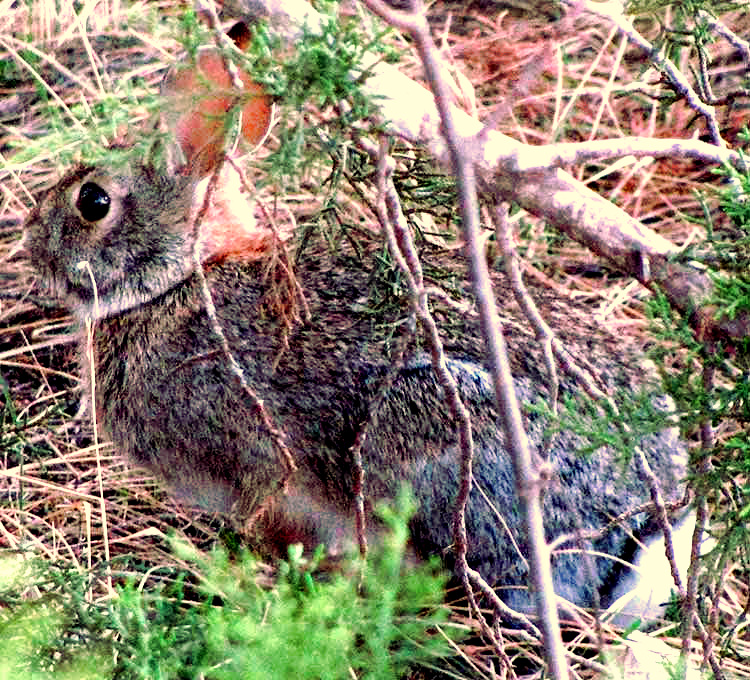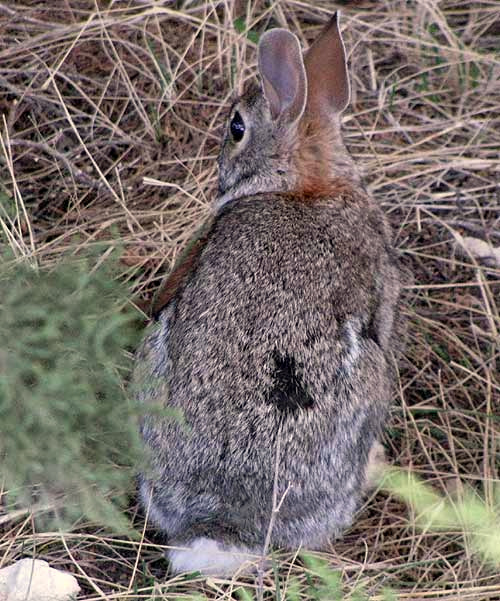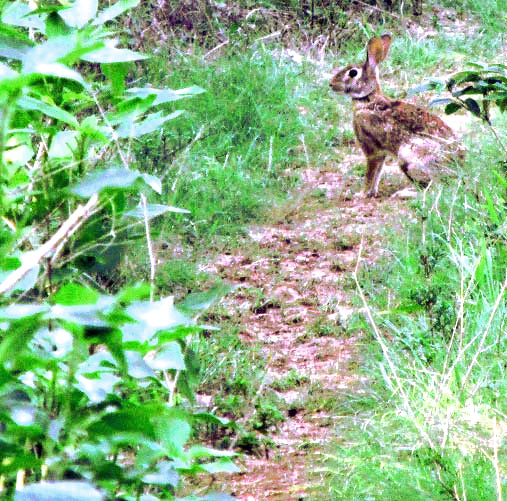Excerpts from Jim Conrad's
Naturalist Newsletter

from the February 24, 2013 Newsletter issued from the valley of the Dry Frio River in northern Uvalde County, southwestern Texas, on the southern border of the Edwards Plateau; elevation ~1750m (~5750 ft); N29.62°, W99.86°; USA
EASTERN COTTONTAIL
In this area at dusk and dawn you see large Black-tailed Jackrabbits as well as much smaller cottontails. I've tried many times to photograph the cottontails but in such dim light it's been impossible to get a good picture. However, this week a bit before dusk a cottontail streaked across the road, then froze beneath an Ashe Juniper a stone-toss away, apparently thinking his camouflage made him invisible. That's him above
A rear view -- the black patch on the back apparently being a wound -- is shown below:

I've wanted a picture because in this part of the world we have two very similar cottontail species and I've not been sure which one is so abundant around the cabin. Now with such fine views I think the picture shows an Eastern Cottontail, SYLVILAGUS FLORIDANUS, the same species so common in eastern North America. The other cottontail species also occurring here is the Desert Cottontail, Sylvilagus audubonii, differing from the Eastern in that its ears are relatively larger, its fur is somewhat lighter, and our river-valley environment is more like what's described for the Eastern Cottontail than for the Desert.
In western Kansas the two cottontail species' distributions similarly overlap. A University of Kansas webpage says that "The desert cottontail is difficult to distinguish externally from the eastern cottontail, but is paler, and has longer and more thinly haired ears. Its upperparts are pale grayish brown heavily lined with black and with some yellow."
It continues, "Desert cottontails are usually found in dry, open upland habitats, whereas eastern cottontails in the same areas of western Kansas are restricted to riparian thickets along streams."
Eastern Cottontails are distributed throughout all of the US except northern New England, south throiugh eastern and central Mexico, and spottily into northern South America. Here we're close to their western boundary.
Each morning a little before dawn I jog by a neighbor's house where numerous dogs perpetually bark and chase whomever passes down the road. The neighbors also set rabbit traps for rabbit stew, though mostly they trap only their own dogs. The amazing thing is that every morning several cottontails can be seen grazing the grass lawn there and along the road, peacefully coexisting with these hysterical, neurotic dogs.
Entry issued on June 16, 2019, from Tepakán, Yucatán, MÉXICO
COTTONTAIL IN YUCATAN, MEXICO
In early morning just as color was coming into the landscape, along the forest trail I jog, a flash of white that bobbed up and down, then disappeared, caught my attention. Then I saw it, ears high, black eye surrounded by white, and the unmistakable profile of the Eastern Cottontail, SYLVILAGUS FLORIDANUS, shown below:

I've seldom seen Eastern Cottontails in southern Mexico, though they're distributed from southern Canada south through the eastern US and certain parts of the West, south through Mexico, and most of Central America, even occurring in northern South America.
Over this large distribution, the species has fragmented into about 18 geographical subspecies, a subspecies being a population whose members display recognizable, inherited features distinguishing them from other members of the species, but still are able to interbreed with individuals of their species in geographical regions beyond their own. It's the species in the process of evolving new species, but not finished with the job, and may not finish if the subspecies' genome somehow starts mingling much with the genome of other members.
All the subspecies of Sylvilagus floridanus can be referred to as Eastern Cottontails, though each subspecies may have its own common name, which is the case with our Yucatan subspecies. Our rabbits are Sylvilagus floridanus ssp. yucatanicus, known as Yucatan Cottontails.
The rabbit in our picture seems to have longer ears and a less rounded body than those I remember from the Kentucky farm. If that's right, it wouldn't be surprising, because in the study of ecology, "Allen's Rule" states that among geographical races of single species, certain extremities of animals are relatively shorter in the cooler parts of a species' range than in the warmer parts. That's because most of a body's heat is lost near the body's surface, so the less surface area a body has relative to its total volume, the less heat will be lost from the surface. That encourages populations in cold climates where heat needs to be retained to evolve shorter ears and more rounded bodies, while those in hotter regions where individuals may be happy to cool off have longer ears and less rounded bodies.
from the July 6, 2003 Newsletter issued from the woods just south of Natchez, Mississippi, USA
GRAZING RABBIT AT DUSK
Dusk usually finds me sitting in my rocking chair reading in the office/barn's breezeway, binoculars ready beside me. That position affords a wonderful view toward the west across the Loblolly-sapling field, to the tree line along Sandy Creek, and beyond. You can see a fine picture of me in the breezeway, taken by my neighbor Karen Wise, at www.backyardnature.net/j/jimsdoor.jpg
Often when I'm sitting there a certain young Eastern Cottontail, SYLVILAGUS FLORIDANUS, forages in the grass about 30 feet away. When he appears I put down the book, bring up the binoculars, and watch. I'm always impressed by two observations.
First, a rabbit's head and neck are strikingly similar to those of a deer, just much smaller and with the snout shorter. They're the same color, have similar short, thick fur, and both have wide cheeks, big black eyes and noses, and tall, slender, ever-twitching ears. Of course such similarities might be expected because both rabbit and deer reside near the bottom of the food pyramid where both spend a lot of time nibbling herbage.
The nibbling is the second interesting point. The rabbit I watch snips off a grass stem, then that entire stem disappears into the rabbit's mouth, and it's the same with the next grass stem, then the next and the next. One just wonders how a little rabbit can consume and digest such a large mass of coarse, tough roughage. Naturally, this wonder sent me Googling the keywords "rabbit digestion."
From my own hunting days as a kid on the Kentucky farm I remember that rabbits contain more than their share of guts. To be precise, a Googled-up site informed me that a rabbit's digestive system accounts for almost 20% of it's weight. The fact I hadn't known earlier was that this impressive gut produces two distinct types of feces.
When a rabbit eats, its food goes down the esophagus into the stomach, which does little more than sterilize the food and forward it into the small intestine. While in the small intestine up to 90% of the protein, starches and sugar are absorbed. After these nutrients are removed, the small intestine sorts what's left. Undigested fibrous material is passed into the colon, where it is formed into the hard, round pellets we often find in our gardens, for, once the pellets are formed, they are defecated.
However, that's not the whole story. The small intestine's softer, moister food, instead of being sent into the colon like the hard, round pellets, is shunted into a special pouch known as the caecum (SEE- kum). Here anaerobic bacteria ferment the material, making vitamins and proteins available. Part of this is absorbed into the rabbit's body, but some is left, and what is left is then formed into a second kind of pellet. These pellets are soft and moist, and known as caecotrophs. The caecotrophs are then emptied from the caecum, pass through the colon, and are finally voided.
Therefore, rabbits excrete two kinds of pellets, one being hard, dry and spherical (the ones we find in our gardens), and the others, the caecotrophs, being soft, moist and clustered together like grapes.
We seldom see caecotrophs, however, because they are typically expelled at night and, more to the point, the rabbit quickly eats them, typically taking them directly from its anus. Of course this is done to recycle the nutrients, to assure that none are wasted.
from the June 29, 2006 Newsletter issued from Polly's Bend, Garrard County, in Kentucky's Bluegrass Region, USA
COTTONTAIL LIPS
When I have a book to read, late each afternoon either I settle in the swing beneath Ruth's big Sugar Maple or else at the picnic table beneath the big American Elm beside the old house, and read. While I'm reading I remain so quiet and still that birds and cottontails often draw near.
One afternoon this week a cottontail hopped leisurely to just a few feet away, nibbling weeds. I had a good view but, still, when he approached a Chicory stem, sniffed it, and got the stem into his mouth, it was like magic. Snipping the stem and working it around so that the stem's base stuck into his mouth happened so quickly that my mind simply didn't register it. One moment the stem was standing being sniffed, then almost instantly it was in the rabbit's mouth being nibbled as the whole stem, flower-buds and all, disappeared into the rabbit, bottom first. Then the rabbit hopped up to another Chicory stem and the entire procedure was repeated.
Maybe a younger person with a quicker mind would have seen the labial manipulation that got that stem into the rabbit's mouth. As far as I was concerned, however, the cottontails' prehensile lips had committed nothing less than legerdemain.
"Prehensile" means "Adapted for seizing, grasping, or holding, especially by wrapping around an object." Monkeys and Opossums have prehensile tails, and rabbits have prehensile lips. On the Internet I read that rabbits can survive when their incisors are missing because their lips can pull food into their mouths even when it's not been clipped.
Seeing the rabbit's prehensile lips in action wasn't the only remarkable thing beheld that day. The other was the shear quantity of vegetable matter the critter put into his gut.
But, we shouldn't judge a rabbit's eating capacity by comparing the rabbit's size to our own, then extrapolating the amount we eat to what the rabbit must eat. That's because rabbit digestion depends very much on the phenomenon of "hind gut fermentation."
In other words, rabbits come out at dawn and dusk (they're "crepuscular") and eat huge quantities of high-fiber vegetation, then go someplace and basically hide for the rest of the day or night while bacteria in their hind gut digest the food. Bacterial digestion in the gut also happens in humans, but not nearly to the same extent. However, at one time the human digestive tract was more rabbitlike than now, the human appendix being an evolutionary relict from those times. Now our appendixes are useless but in earlier evolutionary times they served our intestines the way a rabbit's cecum (SEE-kum) still serves the rabbit.
The rabbit's cecum is a sort of large bag into which recently chewed vegetable matter is temporarily stored for bacterial fementation. In the cecum, indigestible fiber is converted into nutrients.
The cecum is much more than just a bag, however. At certain times of the day the cecum sends a signal to the rabbit's brain that it's about to expel through the rabbit's tail-hole the nutrient-rich remains of the cecum-bacteria's hours of work. The remains are packaged into small, round, moist, green-to-brown, mucous-coated pellets called "cecotropes." When the cecotropes emerge, the rabbit is usually waiting. He's bent around making us think that he's grooming his rear end but, actually, he's gobbling up those nutritious cecotropes which, this time passing through the digestive system, won't be shunted into the cecum.
A lot of people who raise rabbits in cages don't even know about cecotropes because nearly always the cecotropes are eaten before anyone sees them. Sometimes one or two are spotted on the cage floor, and then the owner thinks maybe the rabbit is sick.
from the July 27, 2006 Newsletter issued from Polly's Bend, Garrard County, in Kentucky's Bluegrass Region, USA
COTTONTAIL CHARCOAL
Right before dusk, Cottontails are thick around here. They're the same ones every night. I know because I've learned the notches in their ears, and their scars. Each Cottontail has his or her own personality and they feel like family.
One spot they return to again and again is my campfire fireplace where they gnaw on charcoal from my morning fires. I've never read or heard about rabbit affinities for charcoal, so this is something that surprises me.
I'm guessing that they simply have a taste for charcoal, even though charcoal doesn't have much nutritional value.
One thing charcoal does have, however, is medicinal value, and I just wonder if maybe Cottontails have evolved predispositions for giving themselves occasional good charcoal treatments?
Medicinally, charcoal functions as an adsorbent of particles and gasses in the body's digestive system. Note that the word is "adsorbent" and not "absorbent." "Adsorption" refers to a "sticking-to" of molecules of gases, dissolved substances or liquids to the charcoal, as opposed to "absorption," which implies a kind of assimilation. Charcoal's adsorption of bodily toxins and ingested poisons was known by the ancients, forgotten, and then fairly recently rediscovered, so that now selling "activated charcoal" in tablets is big business.
In fact, I believe in charcoal, too. More than once I've felt my stomach getting woozy after eating something shady, I'd go scrape some powdery charcoal from charred wood, pour it into a cup of water, and drink it.
So, do Cottontails with their complex hind gut fermentation, which produces so many gasses and fermentation byproducts, know to nibble on charcoal to keep their guts in shape?
Maybe.